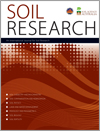We tested the potential of urease inhibitor NBPT and nitrification inhibitor ATC to reduce urea-N loss under cotton and maize. Urea-N loss was substantially reduced by NBPT, whereas ATC increased the loss. The beneficial effects of NBPT were more pronounced with urea applied in subsurface bands than that applied by the conventional broadcast method.

Volume 63 Number 5 2025
Biochar properties change over time, known as ageing, affecting their sorption capacity. However, only three published papers have evaluated soil sorption capacity at least 3 years after biochar application. This lack of information has led to the need for long-term studies on the effect of biochar application on soil. This manuscript focuses on natural long-term biochar ageing in soil up to 6 years after a single biochar application, the fourth longest evaluated period for any organic contaminant in literature.
Sunnhemp (Crotalaria juncea) used as a green manure promotes sustainable agriculture and decreases environmental impacts associated with synthetic nitrogen use, such as nitrate leaching and greenhouse gas emissions.
Biochar research has recently increased due to its effectiveness as a sustainable fertiliser and toxicological adsorbent. However, major oversights appear in the impacts of biochar on arbuscular mycorrhizal fungi (AMF) due to a lack of standardized pyrolysis and application methods. This review paper finds that infrequent biochar application leads to higher AMF root colonisation rates as well as increased biodiversity. Furthermore, conjunctive use of biochar and AMF is useful at increasing drought resistance of crops as water resources become scarce.
SR24123 Abstract | SR24123 Full Text | SR24123PDF (1 MB) Open Access Article
Gravel-sized soil particles greater than 2 mm in size exist in farmers’ paddocks but are routinely excluded from laboratory tests and glasshouse experiments. Ironstone gravel can supply phosphorus to plants, but can also influence other soil properties such as the amount of moisture plants can access. Soils containing large amounts of ironstone gravel are likely to require lower applications of phosphorus fertiliser to achieve maximum crop yield, but can also limit plant growth due to low soil moisture.
SR24151 Abstract | SR24151 Full Text | SR24151PDF (3 MB) Open Access Article
Antarctic tundra soils are cold, harsh environments where bacteria play a crucial role in breaking down plant-derived, large humic substances (HS), vital for maintaining soil ecosystems. This study shows that Antarctic bacteria outperformed fungi in decomposing and solubilising HS, producing smaller compounds that microbes and plants can readily use. Our findings show that warming in polar regions may affect microbial activity and nutrient cycling, and highlights bacterial resilience and metabolic contributions to extreme environments.




